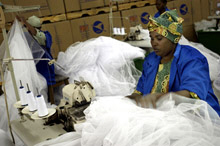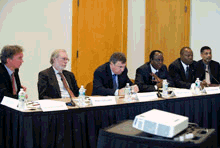IMF Conference

Typical street scene in Santa Ana, El Salvador. (Photo: iStock)
IMF Survey: Building Up Resilience in Low-Income Countries
May 17, 2010
- Clear benefits of integrating with world economy, but more susceptible to shocks
- Diversification is crucial, but challenging
- Multilaterals' loans should be more flexible, better targeted
As economies around the world recover from the global economic crisis, leading economists and policymakers debate the policy options to mitigate and manage risks associated with economic volatility in low-income countries.

Mosquito net factory in Uganda: Increasing resilience requires strong, diversified growth, panelists say (photo: Gianluigi Guercia/Getty Images)
The panelists were in general agreement that increasing the resilience of low-income countries requires strong, diversified growth. They debated how these countries can reap the benefits of globalization while minimizing its costs. They also discussed the official community’s role in helping low-income countries achieve sustained growth.
The panel discussion concluded a one-day conference that was open to the public on “Managing Volatility and Increasing Resilience in Low-Income Countries,” held April 27 in Washington D.C. The event was organized by the IMF’s Low-Income Countries Strategy Unit and the International Growth Centre, and attracted a wide range of participants.
The objective of the conference was to provide a forum for discussing how policies, institutions, and financial instruments can help low-income countries increase their resilience and better manage economic shocks. Some of the themes discussed in the sessions preceding the panel included identifying shocks and their costs, the role of protective (“self-insurance”) measures (including policies, institutions, and reserves) against shocks, and how macroeconomic insurance and hedging could help.
Weathering the turmoil
Perhaps one of the least noticed aspects of the global downturn has been the resilience of the sub-Saharan Africa region—the poorest region in the world—said Francois Bourguignon, Director of the Paris School of Economics and former Chief Economist of the World Bank. He pointed out that for the first time in 30 years, sub-Saharan Africa is growing at permanently positive rates. He also noted that the sensitivity of sub-Saharan Africa to global GDP growth was the lowest and its resilience the highest during the 2009 global crisis compared with previous crises.
The IMF’s Regional Economic Outlook for sub-Saharan Africa said the sub-continent’s output is projected to expand by 4¾ percent this year, up from 2 percent in 2009. But the latest IMF-World Bank Global Monitoring Report warns that the global recession combined with the 2008 food and fuel crisis is having a lasting, negative impact on critical human development indicators.

(From left) Hugh Bredenkamp (IMF, moderator),
Paul Collier, Francois Bourguignon,
Benno Ndulu, Louis Kasakende,
and Arvind Subramanian
(IMF photo)
Country perspectives
Benno Ndulu, Governor of the Central Bank of Tanzania, spoke of his country’s experience in successfully weathering the crisis. By implementing good economic policies over the past 10 years, Tanzania had the policy space to preserve and even increase public spending at a time when revenue was falling, he noted.
Access to financing was another factor that helped Tanzania create the necessary policy space, Ndulu said. In May 2009, Tanzania received a loan from the IMF under the Exogenous Shock Facility—designed to provide policy support and financial assistance to low-income countries facing exogenous but temporary shocks. But Ndulu noted that a range of financing is still out of reach for countries like Tanzania. “We need financing to invest in infrastructure and improve our business environment to reduce the costs of doing business,” he said.
Louis Kasakende, Deputy Governor of the Central Bank of Uganda, agreed with Ndulu that IMF facilities need to be more flexible so that countries can have access to more financing during a crisis. “We need an instrument that is quick disbursing, countercyclical, and that responds to the requirements of our countries,” he said.
Constraints to growth
Arvind Subramanian, senior fellow at the Peterson Institute for International Economics and the Center for Global Development, observed that Africa’s model of growth—which is based on foreign aid and commodity revenues—suffers from two key problems. First, this model is heavily reliant on good governance—a key challenge for the continent, he said. “The second problem with this model is that it creates the wrong price incentives for diversification,” he added.
According to Subramanian, apart from weak institutions, trade policies as well as undervalued exchange rates of key major trading partners have also hurt Africa’s exports. For sub-Saharan Africa, a competitive exchange rate is the best kind of industrial policy because “it’s self-targeted, less demanding of good governance, and it’s self-correcting,” he quipped.
But what should be the role of the international community? “The IMF and the World Bank need to be much more active in terms of ensuring that the policies of member countries are in fact conducive to the interest of the poorest member countries,” he stressed.
Bourguignon took issue with Subramanian’s points, noting that if the money coming from aid and natural resources is well spent, then countries can diversify. Subramanian agreed that aid and commodity revenues can be converted into assets, growth, and development. “But it hasn’t happened much in Africa,” he said.
Is trade the answer?
Picking up on Subramanian’s point on trade policies, Paul Collier, Professor of Economics at Oxford University, agreed that trade preferences from developed countries should be part of the solution. The Africa Growth and Opportunities Act (the U.S. trade scheme for Africa), he stressed, needed to be scaled up. Collier also called on Europe, Japan, and the Group of 20 countries to match this generous preference scheme.
Subramanian said that we should think of more creative and innovative trading schemes for low-income countries, such as providing trade preferences for call centers, for example—an idea that Collier liked very much.
Lending to low-income countries
On the role of international financial institutions, Collier called on the IMF and the World Bank to build in contingencies into their lending programs. Rather than offering fixed-interest lending to low-income countries, Collier said these institutions should link debt service payments to commodity prices, matching importers against exporters. “The idea is when oil prices start to go up, the oil exporters pay more and the oil importers pay less,” he explained. He added that this was a “win-win” for both the IMF and the World Bank (lower risk of defaults on loans) and for low-income countries (smoothes out debt service payments).
Earlier this year, the IMF activated a new package of lending facilities to the world’s poorest nations. The measures, effective January 7, boost lending resources, raise borrowing limits, eliminate interest payments for two years, and offer more flexible terms tailored to country circumstances.
Managing economic shocks
In the earlier sessions, conference participants noted that greater integration with the global economy is likely to further increase the exposure of low-income countries to shocks and heighten risks. The presence of such risks, however, underscores the importance of identifying mechanisms to cushion the blow from adverse shocks and to increase resilience.
Highlights of some of the presentations include:
• Identifying shocks. Economic shocks are more frequent and more costly in low-income countries relative to other countries. Guillermo Perry (Center for Global Development) noted that procyclical domestic policies and limited financial market development tend to amplify the impact of external shocks. Norma Loayza (World Bank) argued that, while openness does lead to more vulnerability to external shocks, this is the cost of doing business in the modern world. Prudent economic policies and political stability, he said, can mitigate the harm from these shocks.
• Protective measures. Flexible economies do better when hit by shocks since they can use more mechanisms to continuously adjust and grow. Collier discussed two types of policies that can protect countries against shocks. First, structural policies (such as facilitating entry and exit of businesses) have advantages since they are already in place before a shock hits. Second, countries need to build a capacity to invest well and to manage making changes in public investment without incurring huge economic costs.
• Economic insurance. Low-income countries would benefit from more economic insurance and hedging instruments, and there could be a role for international financial institutions in facilitating the development of these markets. Perry argued that these institutions could help overcome market failures (for new financial innovations) through coordination, market development, global risk diversification, and technical assistance. Patrick Guillaumont (CERDI/ Université d’Auvergne) suggested that donors offer new concessional lending instruments with floating grace periods that allow countries to postpone debt service when they are hit with a negative export shock, thus providing a type of insurance.
Comments on this article should be sent to imfsurvey@imf.org







